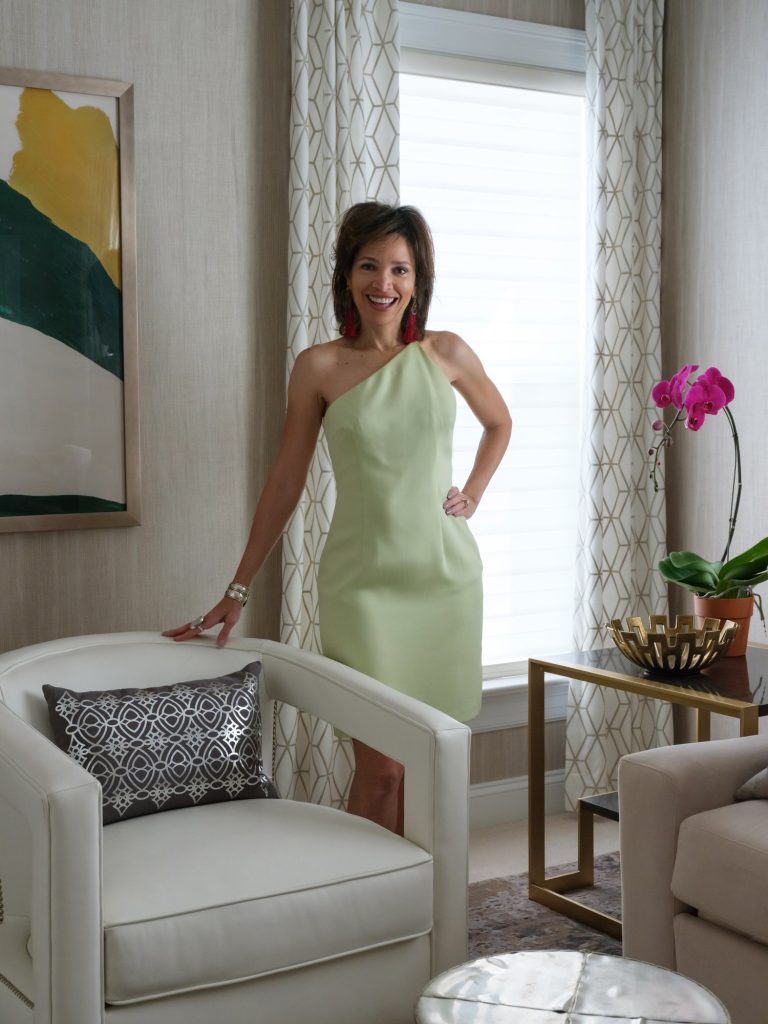The life and career of Lorna Gross-Bryant, MBA, ASID, NCIDQ, reads like plays performed in two acts. The owner of Lorna Gross Interior Design in North Bethesda, MD, was born near New York City. Her father owned a contracting firm. Her mother, a teacher who was also a beautiful seamstress, loved to entertain at the family’s chic suburban home. Parties and dinners featured formal place settings and elegant décor.

“Fast-forward to mid-childhood and we moved to Louisiana,” Gross-Bryant says. “We lived in a small town that was very informal and casual, but so fun. They had crawfish festivals and crab feasts and things like that. Instead of having a cloth tablecloth, meals were served out of large pots with newspaper spread across picnic tables.”
These disparate life experiences gave her an appreciation for diverse cultures and how different people find joy in their everyday lives-two things she draws on regularly when designing for commercial and residential clients. But design is actually her second career. Growing up in small towns, she never knew anyone who was an interior designer and didn’t realize the profession even existed. Interior design has come on in leaps and bounds as trends progress and even revert back to certain times for a modern ‘twist’, with shaggy rugs making a comeback, as well as chrome designs, etc. there is a lot that someone can learn, and that someone was Gross-Bryant.
When she started thinking about what she wanted to do with her life, there were two things she knew. “I wanted to be creative and I wanted to be able to support myself,” she says. “I decided to go into marketing because it was the most creative aspect in business.” She earned a bachelor’s degree and an MBA from the Robert H. Smith School of Business at the University of Maryland, College Park, and went to work for a pharmaceutical marketing company. But even branding and management didn’t provide the creative outlet she craved. Gross-Bryant eventually went back to Marymount University and earned an undergraduate degree in interior design. She opened her firm in 2006.
Since that time, she’s been widely recognized by peers and other professionals. She’s received ASID’s prestigious Designer of Distinction Award as well as the Unique Home Award. She was recently named one of the African American Top 20 Interior Designers by the Black Interior Designers Network and one of the 20 Best Interior Designers in Washington, D.C., by Expertise.com. Spaces she’s designed have appeared in numerous publications, including Home and Design, House Beautiful, The Washington Post and Elle Décor.

Sunny yellow window treatments provide a fresh lift to a relaxed family room. Using a variety of textures, such as a faux croc table and woven frame lounge chair, adds visual interest.
Less Is More for Modern Drapery
Gross-Bryant’s style has been described as layered, dynamic and highly personalized. “For the layered and dynamic part, what you might see on your consumer-oriented websites are nice interiors, but they’re going to be simple. They’re not going to have a lot of layers to them because it takes a lot of thought to pull that together. My goal is always to create a space that, when someone sees it, they think, ‘This would be really hard for me to re-create.'” The key to doing that is to use varied elements, but not so many that the space looks cluttered. She also tries to use a mix of both classic and personalized elements whenever possible, so the space will have lasting appeal. For instance, redesigning one area such as the kitchen with on-trend cabinets and matching fixtures throughout, but then choosing to add a customised neon from a site like www.neonfilter.com can really bring that kitchen together for a family. At the end of the day, it’s about making a house a home which comes from ensuring that it feels clean as well as lived in.
As far as creating personalized spaces goes, “I really like to peel back the layers of my clients to understand what their style preferences are, as well as what makes them happy and joyous in life, and incorporate as much of that as I can into the design,” she says. “Many of my clients are busy corporate executives, and that means their home has to act more like a sanctuary for them. Their life before they walk across the threshold is so busy. Their home should be a place where they can let their hair down.” Lighting is a massive factor to the success of a room too, so making sure you have the right fittings and lights, chrome wall lights could be an idea for example, is the key to giving a room it’s finishing touch.
When she sources custom window coverings, Gross-Bryant tends to stick with clean, simple designs, which means she mostly does panels or shades. “Less is more. We may still do a tape on the leading edge of a drapery, but we probably wouldn’t do fringe.” The swags and tiebacks that were once popular in the Mid-Atlantic region are in much lower demand now.
What clients are requesting is more bold, bright, joyous colors-a look that fell out of favor during the 2008 economic recession but is finally making its way back into homes. “It’s inspired by what the millenials are looking for,” Gross-Bryant notes. Sheers are also very popular.
She’s also getting lots of requests for motorized window coverings. “There are so many more people that are interested in technology and simplifying their lives. Being able to press a button and have all of the window coverings in a room close at the same time is very appealing to clients.”
The Business of Interior Design

Originally a gentleman’s office with circa-1960s knotty pinewood paneling, this space was transformed into a fresh, multiuse study. Silk turquoise, medallion draperies bookend the room and provide a sophisticated pop of color. A striking iron mirror floats above the sofa and opens the room by reflecting its light.
Gross-Bryant’s strong grounding in business principles helped her weather the economic downturn that struck only two years after she’d hung out her shingle. Her background in branding helped her establish a strong identity for the firm and communicate its value effectively. Her ability to manage people ensured she had the support she needed, and her experience with financial statements allowed her to carefully track the bottom line.Providing exceptional customer service is always a critical factor in maintaining a healthy business.
The knowledge she received during her two very different college internships also played a critical role in her success. One internship took place at a showroom. The other was working with a designer who was decorating spaces for a royal family in the Middle East. “Those opportunities help me get an understanding for how the business worked,” she says. “I tried to be observant and take everything in, like a sponge.”
It’s perhaps for that reason that Gross-Bryant highly recommends that designers find a mentor or network of experienced designers who they can rely on for advice and support. “There are so many moving parts in interior design,” she says. “It’s 95 percent logistics. Only 5 percent is the creative piece. Making it happen and executing it is really the lion’s share of what we do if we do it well.” Mentors should have experience in the design industry and understand our industry’s best practices. From there, it’s a matter of finding someone who is the right fit for your personality and goals. For those who are looking to find a pathway in this sector that they can follow and see how they can adjust and adapt their designs when needed, there is an Interview with FSB – TH OWL German that may be insightful in architectural circles for those that need it.

Tall blue and cream draperies soften an octagonal bedroom niche, while light floral fabric hangs from decorative hardware. Silhouette window shades provide privacy in each room at night but are raised and disappear into the casement when not in use to highlight the view of the outdoors.



